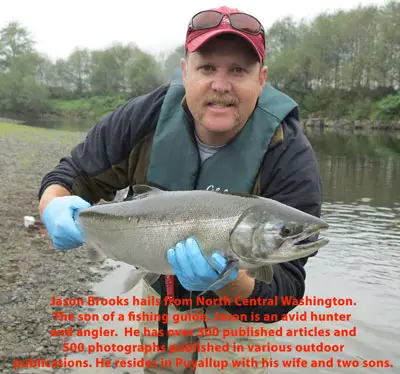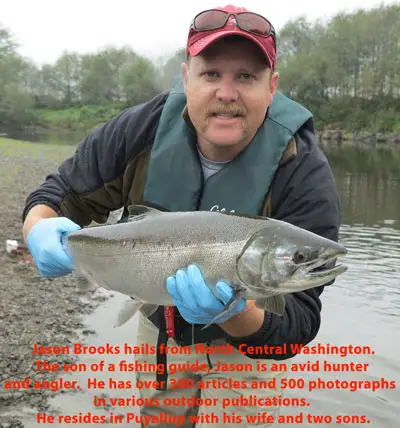Search
Latest Articles
Floating Eggs for Fall Chinook 101
by Jason Brooks, August 25, 2015
Fresh cured eggs are always best so don’t be afraid to use the ones you just cured up last week over the jars that might be in the freezer from last year. With the predicted fall salmon numbers for almost the entire Pacific Northwest you should be able to replace the eggs that you use within the next few weeks. Don’t forget that sometimes it takes a little more than just eggs to turn on the bite. I learned years ago to take along some sandshrimp as well as a few bottles of varying scent. A piece of sardine or herring along with a large gob of eggs and even a combo of eggs, sandshrimp and bait fish can be an effective combination.
After securing enough bait for the day maybe take a look at your fishing set up. Starting with the rod. This is the time to pull the longer and stouter rods out of the back corner of the garage. All summer you might have been fishing with a standard steelhead rod rated for 6 to 12 lbs and fairly limber, even for Pinks I like to fish a light, sensitive rod. Floating baits for big fall chinook means you don’t need to “feel the bite” and you must be able to turn the fish away from any log jams or other fisherman that might cast into your way. Last fall I was promptly reminded of this when I fished the Lower Humptulips during low water. A river that was more like a stream and big fish meant I was way “under gunned” when I needed to turn the fish in the deep holes filled with logs and debris. I lost more fish on my first trip than I landed because I made the fatal error of not using stout enough gear. For fall chinook float fishing I will up my rod to a 10 ft. or 12 ft. rod rated for 15 to 30 pounds. The length of the rod helps with mending the line and its heavy action allows me to tire the fish quickly and bring it to the bank. My preferred rod is the North Fork Custom’s Salmon Series 1064. A 10’6” rod rated for 10-30 lbs that is strong enough to pull fish out of deep holes littered with woody debris and swift currents.
Of course your rod will dictate what type of reel you use. However if you prefer spinning reels keep in mind that they often have a weaker drag system than level wind reels. Spinning reels have some advantages that might offset the drag like being able to make precise casts and are easier to use. When one foot can make a difference in hitting the seam where fish are holding or just a long day of casting practice then a spinning reel might be the right choice. Level wind reels have much heavier drag systems and really are better suited for fighting big fish in tight areas. Though casting a heavy gob of eggs and a weight to get it all down can cause for some serious backlashes if you don’t pay attention while casting.
Mainline is probably the most important part of float fishing. You need to use a line that floats. A few years ago I took a co-worker fishing for a day and he insisted on using his own gear. He showed up with a shorter rod and reel loaded with monofilament. As I tried to explain to him that his set-up wouldn’t work for this type of fishing his reply was “It’s what I always use, so I am going to use it today.” This mentality caused him frustration as we watched his bobber go down twice and he was not able to make a proper hook set with his monofilament line sinking and causing a long belly with too much slack. For a mainline you need one that floats so you can mend the line and control the drift of the float. Think of it like fly fishing where a fly angler mends their line and keeps it floating in the area of the river where the fish are holding.
I prefer either Izorline’s spectra or Suffix 832 braid. The Suffix 832 has seven strands of braid and one strand of Gore-Tex which means it will always float. The spectra or other braided lines float but after time they can soak in water and cause some drag issues along the water’s surface. This is easily fixed by applying fly line dressing or some plain wax to the last 30 to 50 feet of line. I have used P-Line’s “Hydrafloat” in the past which is a coated line but after time the coating has separated from the inner line, especially around where the bobber stop knot is, and weakens the line. But it is a good choice for a single season. Often times I can get a few season’s out of my float fishing gear since it will sit out of the sun, in the corner of my garage when not in use, as it is pretty specific to a fall Chinook fishery.
So, we have discussed baits, rods, reels, and line. Now for the good stuff. On the terminal end I run either a bobber stop knot or a rubber bobber stop, depending on what mainline I am using. It’s your personal preference as I have found the bobber stop knots to be more secure on the line and less likely to travel after multiple casts but I also find them to catch a few of the rods guides if fishing really deep. The rubber bobber stops will slip a bit after a few casts but also don’t catch on the rods guides. If I know I will be fishing really deep holes then I will use the rubber stops but if I am fishing a river with fairly shallow holes and mostly fishing seams I will use the bobber stop knots. After the stop I use a bright colored Lil’ Corky by Yakima Bait Company and then a sliding float. The corky is an indicator that my line is not tangled and that my bait goes all the way down and my float goes all the way up to the stop. The set up should ride straight up and down when floating in the water with the corky on top of the float. After the float comes a small bead to keep the bottom of the float from getting stuck on the swivel. Next comes a sliding snap and a small weight. I usually use a one ounce weight but it all depends on the size of baits I am using and the size of the float.
Floats will be marked and sized by weight which is the amount of weight they can suspend. A 5 ounce float means it can suspend 5 ounces in the water. The main reason I use a sliding snap weight is so when you get the fish close to the net if the weight gets caught in the net and the fish takes off it will pull through, that is until it hits your bobber stop (one more reason to use the rubber stops as it is likely to slide as well if the fish takes off) but this should give you an extra second to turn the fish around instead of it breaking your leader at the net. The main line in then tied to a swivel or bead chain. Brad’s Killer Fishing Gear is coming out with a new all black 4 bead and 6 bead chain which will really help in our low waters we have this fall. It might be a good idea to take a black sharpie and color your weight as well so nothing glistens in the water as it nears the fish. My leader is either clear 20# or 30# Izorline XXX and anywhere from 18 inches to 36 inches depending if I am fishing deep holes or shallow runs. In the middle of the leader are two or three ¼ ounce split shot which helps keep the bait down in any currents. Next is either a 3/0 or 4/0 Brad’s Killer Fishing octopus style hook. These are strong hooks and super sharp, plus they are costs effective and a local company. I do prefer using red colored hooks but in reality it will be mostly covered in bait. Make sure the point is sticking out so when the big Chinook grabs on and the float either stops or goes under you can set the hook and drive it into their upper jaw.
That’s the set-up from start to finish. Fishing eggs (and other baits) under a float is fairly simple. Any holding or even travel areas Chinook are located can be fished easily. Since you are fishing from the surface down you rarely lose gear unless of course you make a cast just a little too close to the log jam where you know that big Chinook is hiding. The idea is to keep you float going along downriver at the same speed the water is. Since there is some “push” of the float moving downstream you will need to mend your line upstream once in a while to keep it floating along at a normal pace. You can also pull your float and bait around structure and extend your float by opening up the bail and letting line out. This is a major advantage over drift fishing as you can extend your bait going down river for several dozen yards past a normal drift. First light always seems to be a great “egg bite” but I have caught Chinook all throughout the day while floating eggs. This is a fun way to fish and a great way to get other’s into fishing as once you have the gear and learn how to float baits it is very productive. You don’t need to concentrate on “feeling the bite” like drift fishing. Instead you can be standing on a riverbank and chatting with friends while float fishing. All you have to do is watch your float and give your friends a bad time when theirs goes down and they don’t set the hook in time because they are too busy talking to you!

